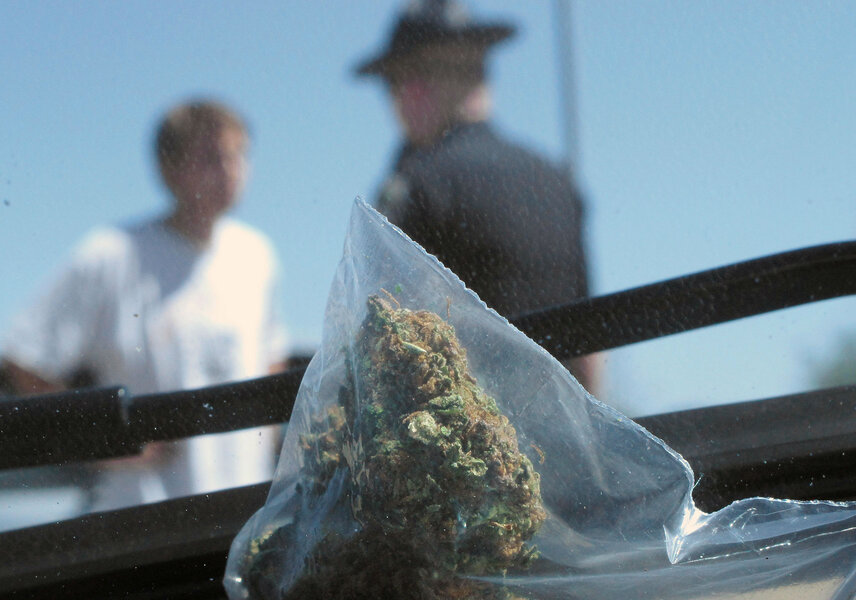Driving under the influence of marijuana? Tests flawed, says AAA
Loading...
| Washington
Six states that allow marijuana use have legal tests to determine driving while impaired by the drug that have no scientific basis, according to a study by the nation's largest automobile club that calls for scrapping those laws.
The study commissioned by AAA's safety foundation said it's not possible to set a blood-test threshold for THC, the chemical in marijuana that makes people high, that can reliably determine impairment. Yet the laws in five of the six states automatically presume a driver guilty if that person tests higher than the limit, and not guilty if it's lower.
As a result, drivers who are unsafe may be going free while others may be wrongly convicted, the foundation said.
The foundation recommends replacing the laws with ones that rely on specially trained police officers to determine if a driver is impaired, backed up by a test for the presence of THC rather than a specific threshold. The officers are supposed to screen for dozens of indicators of drug use, from pupil dilation and tongue color to behavior.
The foundation's recommendation to scrap the laws in Colorado, Montana, Nevada, Ohio, Pennsylvania and Washington comes as legislatures in several more states consider adopting similar laws.
At least three states, and possibly as many as eleven, will also vote this fall on ballot measures to legalize marijuana for either recreational or medicinal use, or both. Several legislatures are also considering legalization bills.
"There is understandably a strong desire by both lawmakers and the public to create legal limits for marijuana impairment in the same manner we do alcohol," said Marshall Doney, AAA's president and CEO. "In the case of marijuana, this approach is flawed and not supported by scientific research."
Determining whether someone is impaired by marijuana, as opposed to having merely
used the drug at some time, is far more complex than the simple and reliable tests that have been developed for alcohol impairment.
There's no science that shows drivers become impaired at a specific level of THC in the blood. A lot depends upon the individual. Drivers with relatively high levels of THC in their systems might not be impaired, especially if they are regular users, while others with relatively low levels may be unsafe behind the wheel.
Some drivers may be impaired when they are stopped by police, but by the time their blood is tested they have fallen below the legal threshold because active THC dissipates rapidly. The average time to collect blood from a suspected driver is often more than two hours because taking a blood sample typically requires a warrant and transport to a police station or hospital, the foundation said.
In addition, frequent marijuana users can exhibit persistent levels of the drug long after use, while THC levels can decline more rapidly among occasional users. Nine states, including some that have legalized marijuana for medicinal use, have zero-tolerance laws for driving and marijuana that make not only the presence of THC in a driver's blood illegal, but also the presence of its metabolites, which can linger for weeks after use.
That makes no sense, said Mark A. R. Kleiman, a New York University professor specializing in issues involving drugs and criminal policy. "A law against driving with THC in your bloodstream is not a law you can know you are obeying except by never smoking marijuana or never driving," he said.
He said rather than switching to a new kind of law as AAA recommends, states should consider simply making it a traffic violation.
Studies show that using marijuana and driving roughly doubles the risk of a crash, Kleiman said. By comparison, talking on a hands-free cellphone while driving — legal in all states — quadruples crash risk, he said. A blood alcohol content of .12, which is about the median amount in drunken driving cases, increases crash risk by about 15 times, he said.
Driving with "a noisy child in the back of the car" is about as dangerous as using marijuana and driving, Kleiman said.
The exception is when a driver has both been using marijuana and drinking alcohol because the two substances together greatly heighten impairment, he said.
As the Associated Press reported previously, studies of marijuana's effects show that the drug can slow decision-making, decrease peripheral vision and impede multitasking, all of which are critical driving skills. But unlike with alcohol, drivers high on pot tend to be aware that they are impaired and they try to compensate by driving slowly, avoiding risky actions such as passing other cars, and allowing extra room between vehicles.
On the other hand, combining marijuana with alcohol appears to eliminate the pot smoker's exaggerated caution and it seems to increase driving impairment beyond the effects of either substance alone.
"We see the legalization of marijuana in Colorado and Washington as a wake-up call for all of us in highway safety," said Jonathan Adkins, executive director of Governors Highway Safety Association, which represents state highway safety offices.
The foundation also released a second study that found the share of drivers in fatal crashes who had recently used marijuana doubled in Washington after the state legalized it for recreational use in December 2012. From 2013 to 2014, the share of drivers who had recently used marijuana rose from 8 percent to 17 percent.
While it stopped short of blaming the crashes on that increase, AAA traffic safety director Jake Nelson said traffic fatalities went up 6 percent in Washington during that same period while the fatalities nationally declined.
___
Online:
AAA Foundation for Traffic Safety https://www.aaafoundation.org/impaired-driving-and-cannabis







